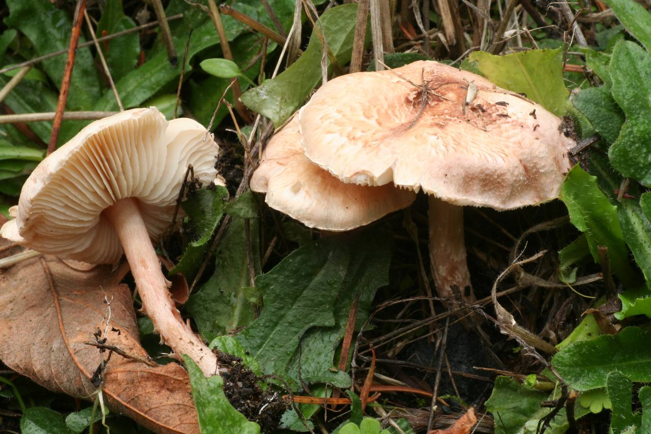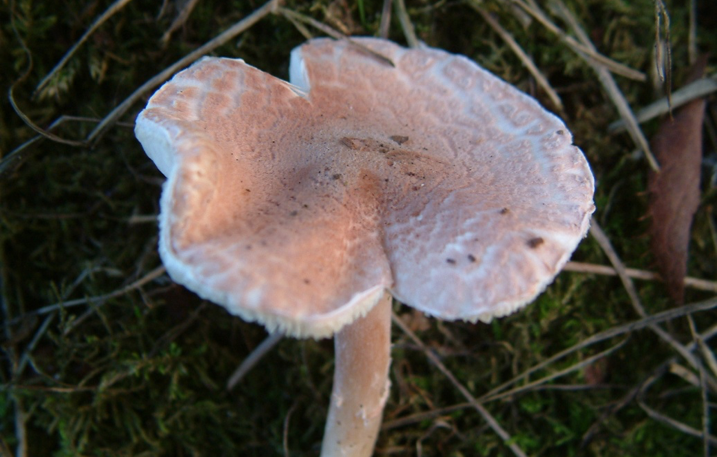
Lepiota subincarnata in Victoria. Photo by Adolf Ceska
Extremely dangerous and potentially deadly, contains toxins that damage or destroy the liver and kidneys.
Toxins: bicyclic peptides called Amatoxins and Phallotoxins
Symptoms: Time of onset 6 to 12 hours (up to 36 hours).
Colicky abdominal pain, vomiting, watery diarrhea: symptoms subside after about one day; then about 72 hours post ingestion, gastrointestinal symptoms recur along with signs of impending liver failure. In fatal cases death occurs 7 to 10 days after the first onset of symptoms.
Small mushrooms common in landscaped areas, in lawns and from soil and tree litter duff, they are saprobes that decompose forest duff. They make white spore prints.
Caps are convex young flattening out with age, dry and rosy pink young to pinkish brown over the centre in age and coated with a wooly or granular looking layer that breaks up into crowded scales over the white background as the caps expand. The shape is often uneven and the cap edge may be somewhat undulating. Flesh is white but staining pinkish where bruised or damaged. The odour is rather sharp and unpleasant.
Gills white, moderately spaced and free from the stem, staining faintly pinkish when bruised or damaged.
Stems 2 to 6 cm long and 2 to 5 mm wide, with a faint zone of whitish veil fragments in the middle or toward the upper portion above which the surface is white, below the veil zone often with pinkish flush and with scattered whitish veil scraps near the base which is slightly expanded but without a bulb. Stem hollow and rather fragile, flesh whitish staining pinkish.

Lepiota subincarnata in Vancouver. Photo by Paul Kroeger
Microscopic: Spores are 5-6 x 3 microns, elliptic, smooth, thick-walled and hyaline without a germ pore, dextrinoid (pale rusty-brown in Melzers iodine solution).
Lepiota subincarnata has caused fatality in BC:
On October 16 1988 a 56 year-old man ate mushrooms picked from his lawn in New Westminster in a breakfast omelette, believing they were Fairy-ring mushrooms. They were later identified as Lepiota subincarnata. 13 hours later the man began to experience abdominal pain, severe vomiting and leg cramps. The following day he was admitted to hospital and by October 18, or two days after ingestion, his condition appeared to have improved though tests indicated that liver damage was occurring. The following day the patient experienced nausea, abdominal pain, vomiting and occasional diarrhea. His condition began to deteriorate on October 20, four days post-ingestion, and he lost consciousness on October 22. He was placed on life support October 23 after renal and hepatic failure. He died October 25, nine days after eating the mushrooms.
Bibliography
Ammirati, Joseph F. 1985. Poisonous Mushrooms of the Northern United States and Canada. University of Minnesota Press
Benjamin, Denis R. 1995. Mushrooms: Poisons and Panaceas. A Handbook for Naturalists, Mycologists and Physicians. W.H.Freeman and Company
Faulstich, H., B. Kommerell and Th. Wieland editors 1980. Amanita toxins and Poisoning. Verlag Gerhard Wilzstrock Baden-Baden Köln New York
Kent, Debra R. and Gillian Willis eds. 1997. Poison Management Manual. The BC Drug and Poison Information Centre Vancouver
Kühner, Robert & Henri Romagnesi 1953. Flora Analytique des Champignons Supérieurs. Masson et Cie, Editeurs Paris
Lincoff, Gary and D.H.Mitchel 1977. Toxic and Hallucinogenic Mushroom Poisoning: A Handbook for Physicians and Mushroom Hunters. Van Nostrand Reinhold Co.
Moser, Meinhard 1983. Keys to Agarics and Boleti. Roger Phillips, London
Turner, Nancy J. and Patrick von Aderkas. 2009. The North American Guide to Common Poisonous Plants and Mushrooms. Timber Press
Willis, Gillian A. 1989 Mushroom poisoning – a case report, B.C. BC Health and Disease Surveillance 10 (2) pp. 22-23.
